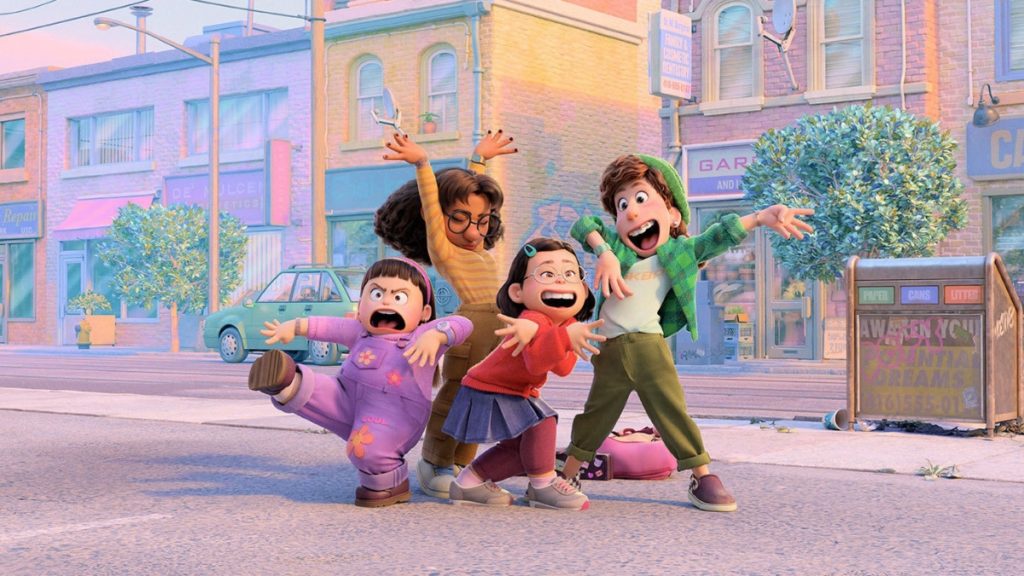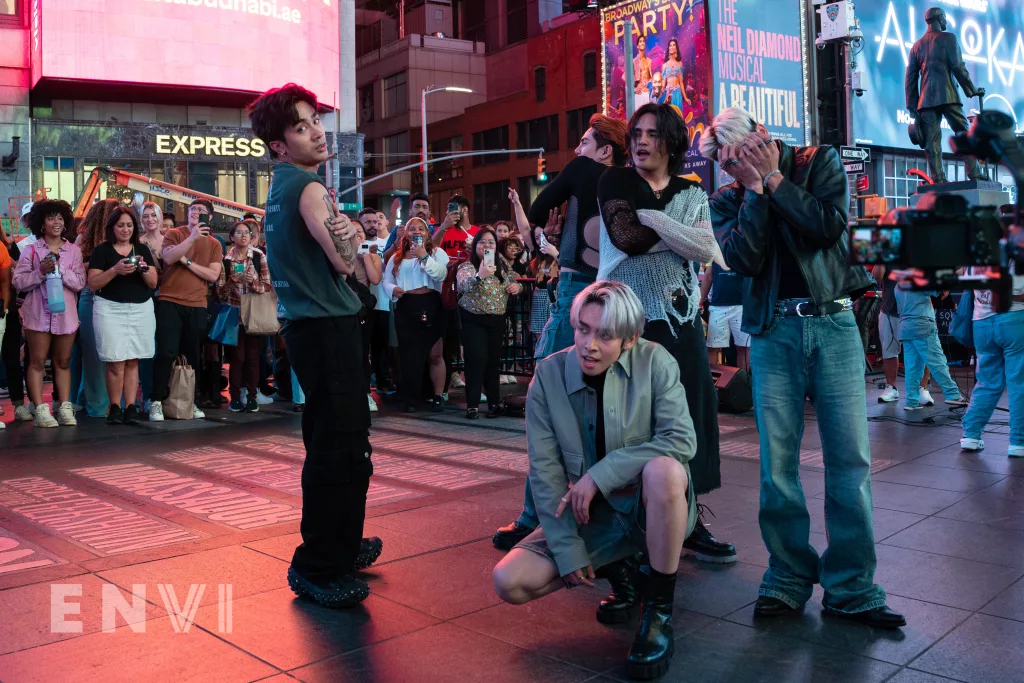First Impressions: “Turning Red” Celebrates the Troubles of Adolescence

Balancing cultural obligations and our growing desire to become our truest selves is a difficult struggle for many and what Meilin (Mei) Lee, the protagonist of Turning Red, finds herself faced with choosing between. Pixar’s latest coming-of-age film is an engaging and touching narrative with hilarious moments of adolescence, enviable friendships, and a familial bond that transcends realms. It brings new meaning to the chaos of growth and discovering one’s own self value.
Set in early 2000s Toronto, Canada, the story follows spunky 13-year-old Mei (voiced by Rosalie Chiang). The seemingly confident Chinese-Canadian preteen is sure of her path in life. Her days are filled with acing all her school courses and dutifully returning home to help out at the family temple. Although Mei is comparably more mature than her peers, she still likes the same things: cute boys and having fun with friends. As many teens will do, she makes sure that her overprotective mother Ming (voiced by Sandra Oh) never sees her perfect daughter going astray from her expectations. For a long time, Mei has enjoyed following Ming’s every word, completing each task with stellar results. It definitely surprises Ming when she discovers her daughter would rather spend time with her friends than with her.
A Record-Breaking Team
Ahead of its release, Turning Red is already breaking records left and right. Besides being the directorial feature debut of Academy Award-winning director Domee Shi, the creator of the 2018 short film, Bao—this is Pixar’s first film to be directed by a woman. Her entire team, dominated by women, have worked tirelessly for four years to bring the film to life. Their hard work and influence are apparent with their realistic portrayal of Pixar’s first Asian protagonist. Claiming many firsts, this film demonstrates the necessity of telling stories from reliable perspectives.
Shi admits the film is a reflection of her youth in Toronto as an only child with overprotective parents. The feature flick is rich in traditional Chinese immigrant culture and makes several homages throughout the film. The scenes and characters also take inspiration from other Asian cultures. There are nods towards anime, which Shi and her team state they could escape to growing up. Additionally, the film’s clear attention to details, such as food, setting, and mannerisms is easily identifiable by Asian audiences. It’s important to note that although Turning Red is an Asian story, viewers regardless of background will find the movie relatable.
Growing Pains
What’s a movie about adolescence if there aren’t the embarrassing moments that come along with growing up? It can be even worse when your mother plays a heavy hand in these incidents even when she means well. Despite the mortifying experiences she keeps going through, Mei never resents her mother for what happens. Rather, she disciplines herself for not acting like the mature adult she perceives herself to be. When Mei suddenly wakes up one day as a ten-foot-tall giant red panda, she’s abruptly thrown into a situation she has no control of. Feeling awkward in her new body, covered in hair, finding out she smells—it’s an experience many can resonate with minus the mystical factor.
Although Mei initially prides herself in being sure of herself, she begins to feel unrecognizable and intimidated. With her insecurities running rampant, so do her emotions as they are linked to her transformations. Mei learns that this isn’t a random mishap and that once a female in her family comes of age, they receive a red panda spirit. During ancient China, the powers were bestowed by the red panda gods on her ancestor to protect her family. Unfortunately, as generations passed and the family tree found itself moving away from their homeland, the powers became more of a curse than a blessing. Luckily, the family members can perform a ritual that can contain the red panda spirit during a rare red moon. However, Mei begins to question if her inner red panda is as detrimental to her life as her family sees it.
Follow Your Heart
Mei’s physical appearance isn’t the only thing changing about her. Her core identity begins seeing a shift too as she becomes interested in activities outside her traditional obligations. Whether it’s dancing to 4*Town’s music or singing karaoke with friends, she finds solace in these moments from her previously restricted lifestyle. The appeal of these spur a change in our protagonist. She turns her problems into an opportunity to see her favorite boy band despite her mother’s protests.
One of the best parts about this film is seeing Mei’s relationships with the people around her. She has a fantastic support system in her three best friends: Miriam, Priya, and Abby. Her sudden changes are embraced with loving arms as they assure her she is still herself and their friend. Coexisting with a red panda spirit, she has a looser grasp of her emotions, which can spill beyond her control. Initially cautious of everything, her squad’s love reinstates her confidence, acting as a neutralizing switch for her inopportune transformations. With their help, she manages to come to terms with her new ability, finding new joy and wonder.
Breaking Out of the Bubble
In Turning Red, the generational trauma is ripe within Mei’s family, showcased by the different bonds between the women. Ming’s mother and herself have a long-standing feud that has resulted in a strained relationship. Although Mei and Ming are much closer, the same issue continues to repeat itself. Mei feels too scared of speaking up and disappointing her mother. With growth comes a natural time that children begin stepping away from their parents to explore their identities. Especially in a cultural household, there is a push and pull between the guilt of filial responsibilities as an immigrant child and seeking independence. As portrayed by Mei and Ming’s increasing tension, this can be a difficult transition. However, once they communicate, there is an understanding that it will be alright even if their relationship has changed.
Embrace Your Inner Panda
Shi states in the Embrace the Panda: Making Turning Red documentary that the red panda was the metaphor she was searching for in a movie about youth and change. She saw similarities in the red pandas and Mei. Their unhealthy bamboo diet is akin to a teen’s desire for junk food. Both are also attached to their mothers and have Chinese roots. The addition of the magical powers that Mei could barely manage were reminiscent of the unpredictability that came with adolescence.
A constant motto for the masterminds behind the movie, “Embrace your inner panda,” is more than just a saying. It’s the very core of the film, showing the viewers that they shouldn’t have to hold back to please others. By revealing your suppressed emotions, you can step into your own identity. Not only will others better understand you, but you’ll also be able to flourish. Puberty can be as terrifying as a big red “monster,” but it’s a rewarding hurdle to overcome with the acceptance of loved ones. Welcoming all our imperfections is how we grow up and become comfortable with releasing who we truly are.
Make sure to watch Turning Red, premiering exclusively on Disney+ Friday March 11, 2022 at 12AM PT worldwide!
Want more Disney+ content? Check out the upcoming Korean Disney+ shows coming to the platform later this year here!



